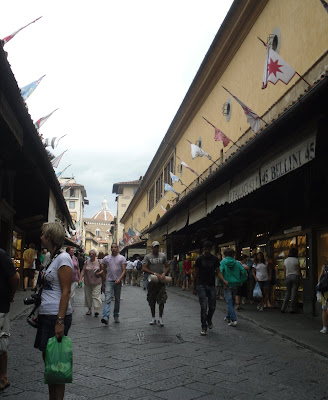Further info on the bridge can be found here - http://en.wikipedia.org/wiki/Ponte_Vecchio
Lovers Locks on the Ponte di Vecchio - the same the world over...
WikiPedia says of this practice: "Along the Ponte Vecchio, there were many padlocks locked to various places, especially to the railing around the statue of Benvenuto Cellini. This is a recent tradition for the Ponte Vecchio. It was perhaps introduced by the padlock shop owner at the end of the bridge. It is popularly connected to idea of love and lovers: by locking the padlock and throwing the key into the river, the lovers became eternally bonded. This is an example of the negative impact of mass tourism: thousands of padlocks needed to be removed frequently, spoiling or damaging the structure of the centuries-old bridge; however, it seems to have decreased after the city administration put a sign on the bridge mentioning a 50€ penalty for those caught locking something to the fence."
Displays of coral and precious metal jewellery
The bridge is lined with amazing jewellers shops on either side...
During World War II it was the only bridge across the Arno that the fleeing Germans did not destroy. Instead they blocked access by demolishing the medieval buildings on each side.
The bridge has always hosted shops and merchants who displayed their goods on tables in front of their shops, interestingly, it is claimed that the economic concept of bankruptcy originated here: when a merchant could not pay his debts, the table on which he sold his wares (the "banco") was physically broken ("rotto") by soldiers, and this practice was called "bancorotto" (broken table; possibly it can come from "banca rotta" which means "broken bank"). Not having a table anymore, the merchant was not able to sell anything






No comments:
Post a Comment
I love to hear what you think! Please leave a comment x